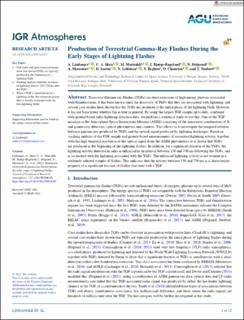| dc.contributor.author | Lindanger, Anders | |
| dc.contributor.author | Skeie, Chris Alexander Kallevik | |
| dc.contributor.author | Marisaldi, Martino | |
| dc.contributor.author | Bjørge-Engeland, Ingrid | |
| dc.contributor.author | Østgaard, Nikolai | |
| dc.contributor.author | Mezentsev, Andrey | |
| dc.contributor.author | Sarria, David Alexandre Stephan | |
| dc.contributor.author | Lehtinen, Nikolai Grigorievich | |
| dc.contributor.author | Reglero, Victor | |
| dc.contributor.author | Chanrion, Olivier | |
| dc.contributor.author | Neubert, Torsten | |
| dc.date.accessioned | 2022-04-19T12:49:18Z | |
| dc.date.available | 2022-04-19T12:49:18Z | |
| dc.date.issued | 2022 | |
| dc.identifier.issn | 2169-897X | |
| dc.identifier.uri | https://hdl.handle.net/11250/2991338 | |
| dc.description.abstract | Terrestrial Gamma-ray Flashes (TGFs) are short emissions of high energy photons associated with thunderstorms. It has been known since the discovery of TGFs that they are associated with lightning, and several case studies have shown that the TGFs are produced at the initial phase of the lightning flash. However, it has not been tested whether this is true in general. By using the largest TGF sample up to date, combined with ground-based radio lightning detection data, we perform a statistical study to test this. One of the TGF missions is the Atmosphere-Space Interactions Monitor (ASIM) consisting of the innovative combination of X- and gamma-ray detectors, optical photometers and cameras. This allows us to investigate the temporal relation between gamma-rays produced by TGFs and the optical signal produced by lightning discharges. Based on stacking analysis of the TGF sample and ground-based measurements of associated lightning activity, together with the high temporal resolution of the optical signal from the ASIM photometers, it is shown that TGFs are produced in the beginning of the lightning flashes. In addition, for a significant fraction of the TGFs, the lightning activity detected in radio is enhanced in an interval between 150 and 750 ms following the TGFs, and is co-located with the lightning associated with the TGFs. The enhanced lightning activity is not evident in a randomly selected sample of flashes. This indicates that the activity between 150 and 750 ms is a characteristic property of a significant fraction of flashes that start with a TGF. | en_US |
| dc.language.iso | eng | en_US |
| dc.publisher | American Geophysical Union | en_US |
| dc.rights | Navngivelse 4.0 Internasjonal | * |
| dc.rights.uri | http://creativecommons.org/licenses/by/4.0/deed.no | * |
| dc.title | Production of Terrestrial Gamma-Ray Flashes During the Early Stages of Lightning Flashes | en_US |
| dc.type | Journal article | en_US |
| dc.description.version | publishedVersion | en_US |
| dc.rights.holder | Copyright 2022 the authors | en_US |
| dc.source.articlenumber | e2021JD036305 | en_US |
| dc.identifier.doi | https://doi.org/10.1029/2021JD036305 | |
| dc.source.journal | Journal of Geophysical Research: Atmospheres | en_US |
| dc.identifier.citation | Journal of Geophysical Research: Atmospheres. 2022, 127 (8), e2021JD036305. | en_US |
| dc.source.volume | 127 | en_US |
| dc.source.issue | 8 | en_US |

